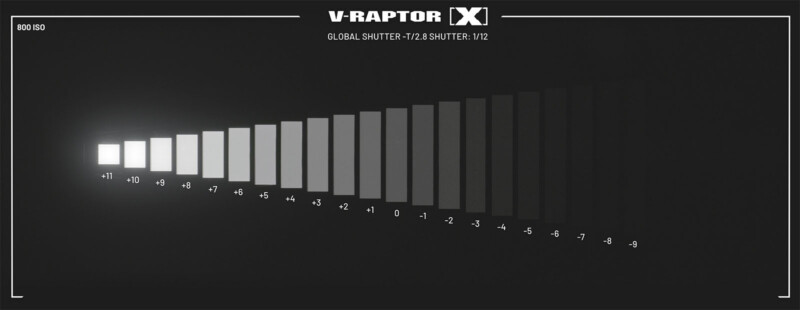
Last week, RED unveiled a pair of new large-format global shutter cinema cameras, the V-Raptor (X) and V-Raptor (X) XL. Tedious model names aside, these cameras have 40.96 x 21.6-millimeter image sensors and make lofty promises concerning dynamic range.
RED claims that the cameras offer 17-plus stops of dynamic range in normal shooting modes and a staggering 20-plus stops with a new Extended Highlights feature enabled. If these claims seem hard to believe, that’s because they are. It isn’t clear precisely how RED calculates it dynamic range figures, as the company does not offer any details and says only that its specs, “reflect both current and projected information,” whatever that means.
For example, RED claims over 17 stops of dynamic range for its standard RED V-Raptor 8K VV camera, which does not include a global shutter sensor. In CineD‘s testing, that camera delivers impressive dynamic range but falls a few stops short of its promised performance.
PetaPixel‘s Jordan Drake has worked with RED cameras before and says they have not matched the promised dynamic range performance in his experience. One such camera is the Komodo.
“RED claims 16.5+ stops of dynamic range, but take that figure with a grain of salt. People have independently tested the Komodo and it doesn’t have anywhere near 16+ stops of dynamic range. I really wish companies wouldn’t exaggerate dynamic range numbers,” Matthew Allard, ACS, wrote on News Shooter last year when RED announced the Komodo, its first camera to include a global shutter sensor, albeit a relatively small one.
If RED’s ambitious claims proved untrue in prior cases, there’s little reason to believe anything different with the latest Raptors. That said, RED is far from the only company to make bold claims concerning dynamic range performance that real-world tests don’t corroborate.
There are also technical limitations to consider. A 14- or 16-bit AD/Converter cannot deliver dynamic range beyond 16 stops, even if the image sensor were theoretically capable of doing so.

But what does RED have to say about its new Extended Highlights feature?
“Extended Highlights is a beta feature designed to capture more color and detail in the extremely bright portions of your image. It uses multiple exposures to reconstruct previously clipped detail in the most faithful way possible. There are no adjustments or levers for the Extended Highlight process, it is simply an On or Off feature,” RED explains in a support article.
Given that the feature uses multiple exposures to rescue lost highlights, thereby expanding dynamic range, the maximum frame rate per video format is cut in half, suggesting that RED uses a straightforward frame-doubling approach.
This sounds similar to the “Dynamic Range Boost” feature in the Panasonic GH6 camera. In this mode, two ISO values are combined into a single exposure. In CineD‘s excellent GH6 testing, the feature proved effective.
Over at CVP, the team is putting the RED V-Raptor (X) through the paces and has published a first impressions video. It seems RED’s new cameras are extremely powerful even if they inevitably won’t quite match dynamic range specs.
“This new sensor is incredible,” CVP explains. “From our initial testing, it looks to combine the excellent image quality and performance of the original Raptor VV sensor with the benefits that come from a global shutter used in cameras like the Komodo. The big benefit of a global shutter sensor is the lack of rolling shutter artifacts.”
Whereas the previous Raptor VV sensor — not a global shutter sensor — suffered quite heavily from rolling shutter, the new one, of course, doesn’t. However, in the case of the Sony a9 III, which also employs a global shutter, there is an image quality cost.
Doubts concerning dynamic range aside, CVP says that the Raptor (X)’s image quality is pretty much the same as its predecessor. That is a remarkable achievement if it stands up to further testing. There is so much that seems legitimately impressive about RED’s new V-Raptor (X) cameras that it calls into question the need to make claims that seem, time and again, detached from reality.
The problem with exaggerating dynamic range performance, even if the actual performance is legitimately excellent, is that not only is it misleading, but it’s nearly impossible to ever walk back. At this point, if RED started marketing its cameras with dynamic range figures that line up with third-party testing, it would seem like RED has taken a major step back in terms of performance, even if that is not what happened.
